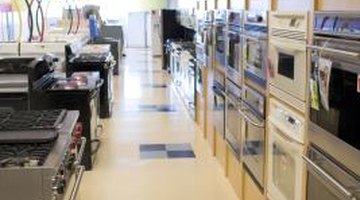Risks of an Infrared Oven
As technology has improved over the years, people have been able to do a lot more in shorter amounts of time. For instance, making phone calls through cell phones, texting, emailing, faxing and even cooking foods are all examples of how technology has helped humanity become quicker and more efficient. Using infrared heat to cook with is one way in which people can prepare meals faster, but certain risks do exist.
How Infrared Heat Works

The infrared light that is used in infrared ovens produces heat at a higher frequency than those used in traditional ovens. Infrared ovens are able to cook the inside and the outside of foods at the same time because there are two sets of infrared heat waves that go out. The first consists of higher frequency heat in short intervals; the second are lower frequency heat waves that are in longer intervals. This allows people to cook their foods at rates close to 50 percent faster than they can in traditional ovens.
Types of Infrared Ovens
Several types of infrared ovens are on the market. Many people think that microwaves and toaster ovens use infrared heat, which is true. Microwaves just aren't nearly as high-powered as some infrared ovens are. For instance, many industrial ovens used to cook hamburgers, bread, chocolates and other types of foods use infrared heat to cook/bake foods with. There are also smaller high-powered infrared ovens -- for example, Nuwave and Infrawave Oven -- available for anyone to purchase. These ovens are often advertised by detailing how fast they can cook a small chicken or other types of foods.
Increased Heart Disease
Some health risks are associated with cooking with infrared ovens. One such risk is increased cholesterol found in dairy products when heated with infrared heat. All milk has natural cholesterol in it; however, when it is heated in a microwave or another type of infrared oven, the natural composition of cholesterol is changed into oxidized cholesterol, which increases the chances for heart disease. The "Pakistan Journal of Nutrition" released a study in one of its 2005 issues that stated that milk heated with infrared heat had the highest amounts of cholesterol oxidation than any other form of heated milk.
Loss of Vitamin B12
Vitamin B12 is one of the most critical vitamins as it helps regulate red blood cells, keep the nervous system working properly and prevent diseases, such as cardiovascular disease, dementia and Alzheimer's. Therefore, it's important that to get the appropriate amounts of B12 through your daily diet. However, the use of infrared ovens poses a threat to this as they have been shown to drastically reduce the amount Vitamin B12 found in the foods they cook. In 1998, a study in the Journal of Agriculture and Food Chemistry showed that foods cooked in a microwave lost up to 40 percent of the Vitamin B12 originally found in them.
Resources
Writer Bio
Kirsten Silven-Hoell began working as a freelance writer and editor in 2004 after spending six years in the financial services industry. She worked as editor-in-chief at "Kentucky Homes & Gardens" magazine for more than three years before becoming editor-in-chief and art director at "Club Solutions Magazine." Silven-Hoell holds a Bachelor of Arts in interdisciplinary humanities from Spalding University and graduated summa cum laude.
Photo Credits
- Creatas Images/Creatas/Getty Images
More Articles



